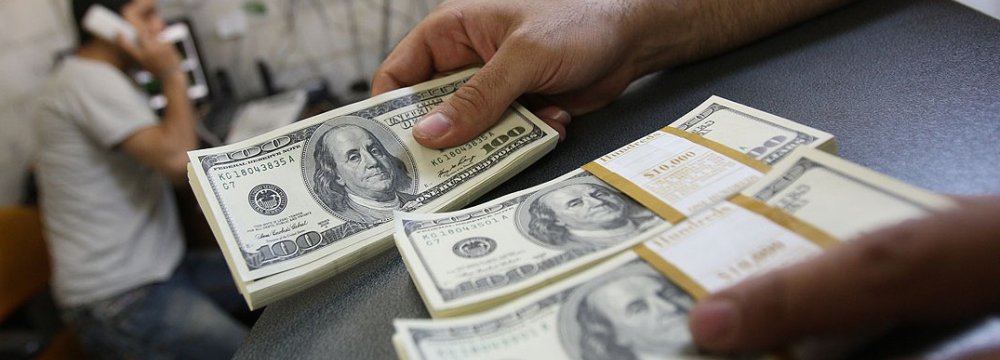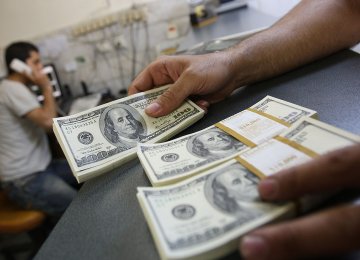Over a month ago the Central Bank of Iran issued a directive which added to prior limitations on currency trade in Iran’s foreign exchange market. Its aim was to increase the central bank’s grip on the market. Its impact can be seen in exchange rate changes in the past month.
In modern economies the stock market is viewed as an indicator or “predictor” of the economy. This role has been taken up by the foreign exchange market in Iran, as the equity market is both too shallow – with major companies remaining state-owned – and manipulated by state affiliated entities.
Thus, in recent years, the importance of political events has been measured by the reaction of traders in the currency market to them. The winning of the presidential race by Hasssan Rouhani in June 2013, for instance, led to the strengthening of the rial versus the US dollar. Also in November 2014, when Iran and the P5+1 – the US, Britain, France, China, Russia and Germany – failed to strike a self-imposed deadline to reach a long-term nuclear deal, the rial lost seven percent in the following weeks.
Dominating Bureaux de Change
The foreign exchange market’s importance to the CBI becomes paramount, when considering its special role in the economy. However, a large portion of foreign exchange transactions are done under the radar, leaving the central bank in the dark. A trend the bank is trying to break.
Unprecedented foreign exchange volatility in 2012 and 2013, which was nothing short of a currency crisis, has raised the need to gain a grip on the market, leading to the steps the CBI has taken in the past year.
Requirement of a permit to give price quotes online, making websites publish price quotes published by the Iranian Exchange Association, ban on currency trading by jewelers and gold traders and the new regulations for bureaux de change activities are the main measures taken by the bank to reign in foreign exchange trade.
The minimum capital for establishing a bureau de change was changed, leading to the closure of smaller bureaux de change. Now larger bureau need to have a minimum of 40 billion rials ($1.16 million at market rate) as capital and smaller ones in minor cities require half that amount.
There was also the imposition of a deadline for extending bureau de change permits, which expanded the central bank’s supervision, despite encountering some resistance.
The bank also expanded its supervision by putting a deadline for meeting the new requirements by exchanges and despite encountering some opposition, refused to extend their permits.
The Unwanted
The new central bank directive regarding currency trading is the extension of the same plan, with the CBI aiming to eliminate black market currency trade.
The new directive, issued in January, has 17 articles, and resorts to the 1972 Banking and Monetary Act.
“Trading, management and clearing foreign currencies in any form” is outlawed by Article 3 of the directive. The effect has been immediate and substantial. Currency trading by people the government derogatorily calls “dealers” has fallen markedly in Ferdowsi Street and Sabze Maydan – the two centers of foreign exchange trading in the capital, Tehran.
The dollar’s volatility range has also dropped to 1,000 rials since the implementation of the directive in the month ending Feb. 19 (Bahman), with the greenback falling one percent to 34,200 by the Iranian month’s end.
Compared to the month ending Dec. 21 (Azar), and the month ending Jan. 20 (Dey), volatility and trading volume have fallen noticeably in Bahman. Yet it is unclear to market observers and the regulator how much of this is due to CBI’s actions and how much due to market conditions, given the fact that no key political or economic developments took place in Bahman.
What can really test the mettle of the new regulations is news of the upcoming talks between Iran and the P5+1 in March, which the market is bound to react to, one way or another.
The ongoing negotiations with the six world powers, which seeks to hammer out a comprehensive nuclear deal to lift sanctions in exchange for Tehran addressing concerns over its nuclear energy program, already extended twice and are due to conclude on June 30; but the framework is to be agreed upon in March.
Investors are cautiously eyeing the negotiations. If talks lead to an increase in safe haven demand like what happened in November, then the volume of trade in Fredowsi Street, currently outlawed, will reveal the effectiveness of the CBI directive.
Barriers
Apart from the ban on free market trading, the directive also imposed new limitations on bureaux de change.
Some of the limitations include the banning of online orders and trading, need to register all transactions in the Sena electronic system, obligation to put price quotes on the shop’s board, doing trade only between 10:00 and 18:00 on working days, and call on the Iranian Exchange Association to publish average trading price on an hourly basis. Also future and forward trading have been severely hindered and require a special CBI permit. Any violators will face criminal charges.
In practice, the confines have led to a drop in trade volume, though not all has been carried out. Price quotas are yet to be published by the Iranian Exchange association, even their website hasn’t been updated to allow for price publishing. Furthermore, Sena’s information has been kept private by the central bank and there are no reports of trade volume or the value of transactions. So much for transparency!
Reading Between the Lines
The government also wants to move all major currency transactions to the bureaux de change owned by banks, as in that case controlling the exchanges will be easier for the central bank, compared to other market participants. Though not directly addressed in the bank’s directives, this aim becomes apparent when one reads between the lines of what monetary officials say.
However one of the main issues for central bank officials is guiding the foreign receipts of state and semi-state owned firms towards certified exchanges.
A large part of Iran’s foreign receipts come from exports by state-affiliated companies. Petrochemicals and metal products come second and third on Iran’s export list respectively, after crude oil. Most of the exporters try to change their revenues to rials in the black market, due to the almost 20 percent difference with which the central bank buys currencies compared to market rates.
After the intensification of sanctions in 2012, when Iran’s banking and oil industries were besieged, foreign exchange volatility increased. To counter shortcomings, the Ahmadinejad administration returned Iran to a multiple exchange rate system. The government created a currency exchange center and asked exporters to sell their foreign earnings there, at an over 40 percent discount to the market rate.
That meant exporters would have to forego a large portion of their earnings. Naturally, companies, even semi-state owned petrochemical producers, resisted and tried their best to avoid exchanging their earnings at the center, ultimately rendering the center worthless.
The Rouhani administration however has tried a different approach, first trying to sort out bureaux de change and now moving to weed out unchartered traders so that all transactions take place and are registered in the bureaux de change network.
Although Ferdowsi Street was the heart of currency trading in Iran, the daily turnover for each of the traders is not that much. It seems that the government’s main hassle is the “invisible” people apparently transferring million dollar sums without leaving a trace, not the “dealers”.
But central bank officials insist they want to crack down on small time traders to sort out the foreign exchange market, leaving out talk of those who can wire hundreds of thousands of dollars to Istanbul or Dubai with one phone call.
What the central bank is truly aiming for is unclear. But without the registration of transactions by the key players in the network, the implementation of the central bank’s directives will all be for naught.





